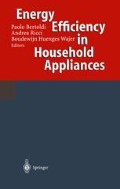Abstract
Residential air conditioners consist of two general types; room and central equipment. Room air conditioners are intended to cool rooms or small spaces while central systems are designed to condition an entire building.
Access this chapter
Tax calculation will be finalised at checkout
Purchases are for personal use only
Preview
Unable to display preview. Download preview PDF.
References
AHAM. 1996. 1996 AHAM Fact Book Chicago, Illinois, USA: Association of Home Appliance Manufacturers.
ARI. 1996. 1996 Statistical Profile of the Air-Conditioning, Refrigeration, and Heating Industry. Arlington, Virginia, USA: Air-Conditioning and Refrigeration Institute
Appliance. 1996. “Portrait of the Japanese Appliance Industry”. Appliance Magazine. Oak Brook, Illinois, USA: Dana Chase Publications, Inc. February, 1996.
IEA. 1996. Heat Pump Energy Efficiency Regulations and Standards. Analysis Report No. HPC-AR4. Prepared by Moebius Research, Inc., San Jose, California, USA for International Energy Agency Heat Pump Centre. June, 1996.
IIEC. 1993. Final Report-Thailand: Promotion of Electricity and Energy Efficiency-Pre-Investment Appraisal. Prepared by International Institute for Energy Conservation, Asia Regional Office, Bangkok, Thailand for World Bank/Global Environment Facility.
ISO. 1994a. ISO 5151: Non-ducted air conditioners and heat pumps-Testing and rating for performance, First Edition. ISO 5151:1994(E). Geneve, Switzerland: International Organization for Standardization.
ISO. 1994b. ISO 13253: Ducted air conditioners and air-to-air heat pumps-Testing and rating for performance. ISO 13253:1994-06-23. Geneve, Switzerland: International Organization for Standardization.
Nadel, S., J.A. Pietsch, and S. Yngyi. 1995. The Chinese Room Air conditioner Market and Opportunities to Improve Energy Efficiency. Washington, D.C. USA: American Council for an Energy-Efficiency Economy. August, 1995.
Nakagami, H. and B. Litt. 1997. “Appliance standards in Japan”. Energy and Buildings. 26 (1997) 1016.
Natural Resources Canada. 1996. Guide to Canada’ s Energy Efficiency Regulations. Ottawa, Ontario, Canada: Natural Resource Canada. May, 1996.
Opheim, K.L. and P. du Pont. 1995. Indonesia’ s Emerging Energy-Efficiency Market — An Interim Report. Washington, D.C., USA: International Institute for Energy Conservation. November, 1995.
Rosenquist, G.J. 1996. “Opportunities for Improving the Energy-Efficiency of Window-Type Room Air Conditioners”. Proceedings of the 1996 ACEEE Summer Study on Energy Efficiency in Buildings. Washington, D.C., USA: American Council for an Energy-Efficiency Economy.
Rumsey, P. and T. Flanigan. 1995. Standards and Labeling-The Philippines Residential Air Conditioner Program. Washington, D.C., USA: International Institute for Energy Conservation. September, 1995.
Turiel, I. 1997. “Present status of residential appliance energy efficiency standards-an international review”. Energy and Buildings. 26 (1997) 1011.
U.S. Office of the Federal Register. 1997a. Code of Federal Regulations, Title 10, Energy. Part 430, Subpart B, Appendix F: Uniform Test Method for Measuring the Energy Consumption of Room Air Conditioners. Washington, DC.
U.S. Office of the Federal Register. 1997b. Code of Federal Regulations, Title 10, Energy. Part 430, Subpart B, Appendix M: Uniform Test Method for Measuring the Energy Consumption of Central Air Conditioners. Washington, DC.
U.S. Office of the Federal Register. 1997c. Code of Federal Regulations, Title 10, Energy. Part 430, Energy Conservation Program for Consumer Products: Final Rule Regarind Energy Conservation Standards for Room Air Conditioners. Vol. 62, No. 185, September 24, 1997, Docket Numbers EE-RM-90-201 and EE-RM-93-801-RAC.
Author information
Authors and Affiliations
Editor information
Editors and Affiliations
Rights and permissions
Copyright information
© 1999 Springer-Verlag Berlin · Heidelberg
About this paper
Cite this paper
Rosenquist, G.J. (1999). Residential Air Conditioners: U.S. Experience and Possible Extensions to the Global Market. In: Bertoldi, P., Ricci, A., Wajer, B.H. (eds) Energy Efficiency in Household Appliances. Springer, Berlin, Heidelberg. https://doi.org/10.1007/978-3-642-60020-3_35
Download citation
DOI: https://doi.org/10.1007/978-3-642-60020-3_35
Publisher Name: Springer, Berlin, Heidelberg
Print ISBN: 978-3-540-65114-7
Online ISBN: 978-3-642-60020-3
eBook Packages: Springer Book Archive

